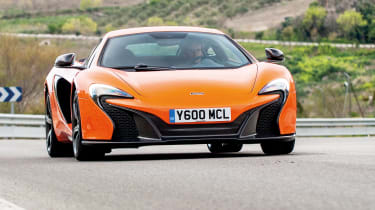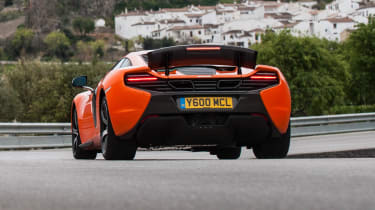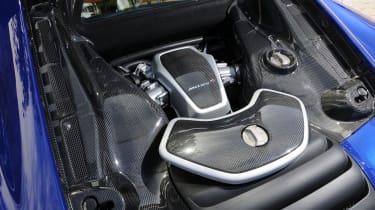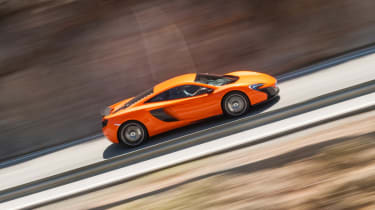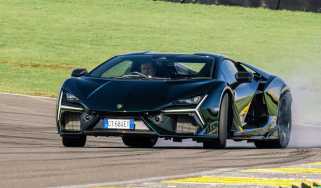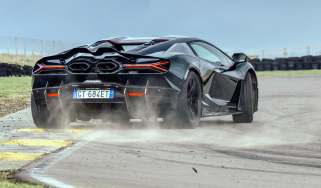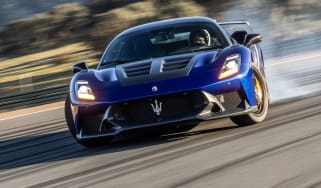McLaren 650S (2014 - 2017): review, specs and buying guide
While it lacks the character of some rivals, stunning composure and pace make the McLaren 650S an excellent supercar offering. Here's how to buy one today
With more style and even more performance than the blistering MP4-12C that came before it, the 650S was a promising new entry to the supercar segment. Launched in 2014 as McLaren Automotive’s second road car since the F1, it built on the same strong formula as its predecessor, only with an increased focus on useability and performance to go head-to-head with the likes of the 991 Porsche 911 GT3 and hardcore 458 Speciale.
Under its restyled, P1-inspired skin, the 650S features an early iteration of McLaren's trademark carbonfibre monocoque. Weighing just 75kg in this form, the underlying structure helped the 650S achieve a 1428kg weight figure, lower than the likes of the 458 Italia despite a sizeable output advantage.
> McLaren 750S 2024 review – V8 supercar primed to take on Ferrari’s 296 GTB
At its core is a development of the 12C’s 3.8-litre twin-turbocharged M838T V8, designed in collaboration with Ricardo. Thanks to the use of new pistons, cylinder heads, exhaust valves and tweaked cam timing, McLaren extracted an additional 25bhp and 58lb ft of torque, bringing total output to 641bhp and 500lb ft. Do the maths and the 650S achieves an astonishing 449bhp/ton power-to-weight ratio, helping it hit 62mph from standstill in 3sec flat and go onto a 207mph top speed – perhaps even more impressive is its 5.7sec 0-100mph time, a figure that puts it half a second ahead of the marque’s iconic 240mph F1 hypercar.
The 650S rides surprisingly well in its default modes, even on less well paved surfaces. Increase the aggression with its 'Active' button though, and it's immediately clear that it's a brutally capable machine, incredibly composed with fantastic carbon ceramic brakes and raw straight line performance to match some of today’s offerings. This said, the 650S was ahead of its time in many ways, launched in a world of emotional, naturally-aspirated heroes that made it feel lacking in its day. In today's hybrid-assisted, forced-induction era though, the 650S slots in nicely, especially when you consider how much they now cost…
Though it came at a £20,000 premium over the 12C at just shy of £200,000 before options, McLaren depreciation worked its magic, bringing earlier, higher-mile examples down to just £85,000. Spend £10-15k more and you’ll have yourself a high-spec example with sub-10,000 miles, with the very best MSO-optioned cars costing in the region of £105,000.
Of course, there are reasons for this. An oversupply of new cars is one possible explanation, but poor overall reliability is the primarily culprit. While there’s not a single point of failure on the 650S, numerous issues relating to poor quality control have been known to surface over the years, ranging from poor panel alignment to spontaneously shattering glass. One plus is that the M838T engine saw use in everything from the 12C to the P1 GTR, and so – while pricey – spare parts (and even engines) aren’t quite as ruinous as something more bespoke.
What we said
'Heading through town and then onto the motorway with the adaptive powertrain and handling modes set to normal it’s really very like a 12C. The spring rates are up by 22 per cent at the front and 37 per cent at the rear, which inevitably has some effect on the ride quality but it’s nothing like as severe as you’d imagine. The smaller bumps seemed to be a bit more noticeable but over bigger undulations there is still that slightly loose-limbed waterbed sensation as it soaks everything up.
The calm only serves to make the storm all the more shocking of course. Pressing the ‘Active’ button so that it glows orange and switching the dials to ‘Sport’ or even ‘Track’ stiffens the 650’s sinews and slices its response times. The combination of the stiffer springs and the Corsa rubber means that you seem to get better initial reaction as you turn into a corner and then more confidence to lean on the front end. Until the tyres have got a bit of heat into them there is a bit of understeer to manage through the tighter corners and you can get the 650 to oversteer if you’re on the throttle with the boost building early enough, but by and large the car is simply stunningly fast and completely composed without an ounce of slip.
In the past this poise would occasionally have been disrupted by the braking, but not any more. The 650 comes as standard with carbon ceramic discs, but where there used to be a horrible dead feeling at the top of the pedal travel followed by an abrupt application of pad to disc, there is now superb feelsome progression.
With an extra 58lb ft over a 12C, the 650S is brutal under full acceleration and what look like slim chances of overtaking opportunities turn out to be gaping great ones as you slot safely back in barely a third of the way to the next corner.
Pure performance has its own thrill, of that there is no doubt, but there’s some emotion still lacking in the 650S. I got to the end of several fast runs feeling in awe of and slightly giddy with the speed, but not elated and grinning at the driving experience. I think a big part of the problem is the sound. The turbocharged engine simply doesn’t make a noise that you crave. There’s supposedly a new cylinder cut on upshifts when you’re in Sport mode, but sadly I couldn’t really detect the added drama it was meant to add and although overall it’s not a bad sound being piped into the cabin, you won’t lie awake at night longing for the next time you hear it.' – Henry Catchpole
McLaren 650S specs
| Engine | 3.8-litre twin-turbocharged V8 |
| Power | 641bhp @ 7500rpm |
| Torque | 500lb ft at 6000rpm |
| Weight | 1428kg |
| Power-to-weight | 449bhp/ton |
| 0-62mph | 3sec |
| Top speed | 207mph |
| Price new | £195,250 |
| Value today | From £85,000 |
